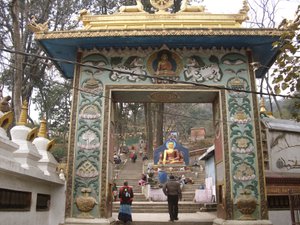Advertisement
Published: February 27th 2012

 Gateway to Swayambhu
Gateway to Swayambhu
Monkeys, tourist, sleeping dogs, beggars, and souvenir vendors congregate at the bottom of the 367 step ascent to the temple and monestary.Tuesday morning Shiva hailed a taxi and we headed to the Swayambhu Temple. By now the smog had Marie wheezing by the effort of simply getting out of bed. When we arrived at the temple there were a few monkeys playing around, some beggars, souvenier vendors, snack wagons, etc. and wide stairs that went straight up seemingly to heaven, (it turns out that there were 367 steep steps to the top). Marie saw the steps and said "I think I stay down here and watch the monkeys and locals."
Shiva and I began our trek up to the temple. We stopped every so often to catch our breath ... even Shiva whose village was high in the Himalays had to take breathers. After 200 steps or so we could finally see the main stupah at the top ... still a long way to go. Vendors pushed their wares on us as we climed, which kept us moving along to lose them.
As we climbed Shiva explained that this monestary was more than 2500 years old. I can only imagine what a breathtaking view it must have offered then when it was surrounded by jungles and had no smog. When

 Painted Stone Carvings Along Stairs
Painted Stone Carvings Along Stairs
About two thirds of the way to the top you come to a series of stone figures that give you a good excuse to stop climbing and take a photo.we got near the top we stopped at a ticket booth - Foreigners must pay $7.50 USD to enter, but this heritage site is free to Nepalis. Seems fair to me. Sure a lot better than Africa Where it costs about $100 to enter Kilamanjaro Park plus you must hire a guide for the day for $150 per day.
When we reached the top we were rewarded with great view of Katmandu below and a whole village of old buildings, temples, stupahs, and souvenier shops. I imagined what the view must have been like 2500 years earlier before the smog and deforestation. Monkeys scampered on the roofs and idols, scratching themselves and grooming one another.
Souvenier vendors had stalls side by side all around the village. A lot of them had the usual tourist items, but several had things I actually considered purchasing. There were many interesting, well-done acrylic paintings of the Himalayas. A few were well-done artistic takes on the mountains that I really liked. One brass shop had a nicely patinaed brass lock in the shape of a fish that I was really tempted to buy, but since Marie wasn't with me I used that as

 Main Stupah at the Top
Main Stupah at the Top
What a relief to get to the top and finally be at the main stupah.an excuse not to buy.
Shiva and I wandered around the whole monestary taking it all in for about an hour before heading back down. When we met up with Marie she was sitting on a bench enjoying watching the locals and monkeys. It was really good that she hadn't tried to climb all those stairs because of here asthma. We stopped for some tea then got a taxi to go back to Shiva's.
Advertisement
Tot: 0.082s; Tpl: 0.01s; cc: 13; qc: 51; dbt: 0.0531s; 1; m:domysql w:travelblog (10.17.0.13); sld: 1;
; mem: 1.1mb

 Gateway to Swayambhu
Gateway to Swayambhu
 Painted Stone Carvings Along Stairs
Painted Stone Carvings Along Stairs
 Main Stupah at the Top
Main Stupah at the Top


